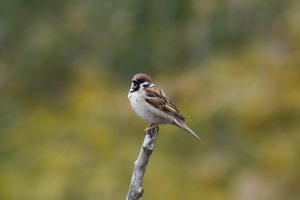Sparrows have always built their homes anywhere that humans inhabit; that is why it is possible to watch them going about their daily life.
I am always fascinated by birds partnering processes if they remain loyal to each other, and if so, do they recognise each other away from the nest?

I wonder, do sparrows mate for life or just long enough to raise a successful brood?
Sparrows are one of the few birds that remain with the same partner and raise multiple young each breeding season.
However, they’re not always monogamous; some sparrows indulge in ‘extra-marital affairs’, away from the nest. It is thought that as many as 15% of sparrow chicks are raised by a father that probably isn’t theirs!
Table of Contents
Why do sparrows mate for life?
The male sparrow is a practical bird that begins building a nest before he has even found a mate. When he sees a particular female that he likes the look of, he performs an impressive courtship display. It includes bobbing up and down, shivering his wings, fanning out his tail, and rearing up to show off his bib.
Their partner selection is based on these factors;
- It’s hard work
Finding a mate takes time and energy; they would rather only do it once and get it right. The time they save is then spent on raising their young and sourcing food.
- Practice makes perfect
Each time they raise a brood they get better at it. The sparrows invest a lot of time caring for their chicks, so their parenting skills improve each season.
- High survival rate
Sparrows that bond over many breeding seasons tend to lay more eggs and their chicks are most likely to survive. This is most likely due to them honing their hunting and feeding techniques.
Are sparrows monogamous
Most house sparrows remain faithful to their mate for life. It is only when one partner dies that the other seeks to replace them.
However, some sparrows are known to leave their nest to copulate with a new partner.
It isn’t always the easiest thing to do as the male fiercely guards the nest to prevent another from entering.
If the females weren’t so aggressive in their jealousy and protection, it is believed that males would have many more partners.
Those females that the male sparrow manages to copulate with, remain close to the nest of the mated pair – at a safe distance. They act as helpers, so in the event of the mother’s death, they are on hand to step into the breach.
Sparrows are faithful to their nesting site
House sparrows need to construct a robust nest as they have up to four broods per season.
A lot of the structural security comes from the building or tree that they choose for their home; sparrows are cavity nesters. They also make free-standing nests in ivy and other creepers.
They tend to add materials between broods but remain in the same nest.
When the breeding season is over, the pair still make use of their nest for resting during the day and roosting overnight.
Once a breeding couple is formed, they are bonded to each other and their nest. The pair also recognise each other away from their roosting spot.
Final thoughts
Sparrows mate for life; sometimes from a very early age. Often they are still fledgelings when they attempt breeding but with little or no success.
As the birds grow older together, their reproduction efforts improve until they are excellent parents capable of raising up to four broods per year.
With their average life span being 4-5 years, it is little wonder the sparrow mates for life, they have no spare time or energy to build a new relationship each breeding season.
